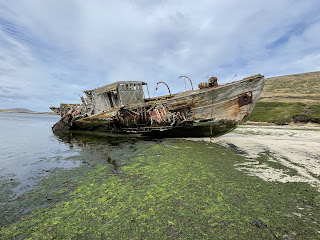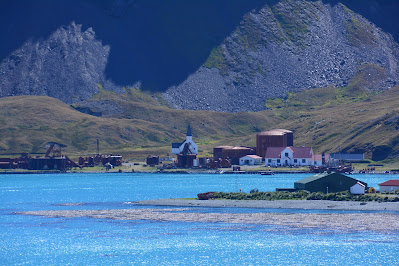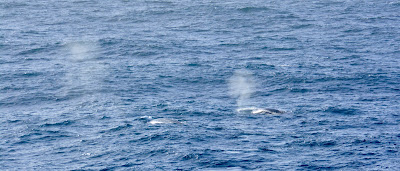Uruguay and Argentina
Monday, February 20, 2023 – Montevideo, Uruguay
After leaving the Falkland/Malvinas Islands we sailed for two days to our first landfall in South America since departing Punta Arenas, Chile on February 2. The first stop was Montevideo, Uruguay on Monday, a national holiday, part of Carnaval. Many, if not most shops were closed, but restaurants and bars were open. That also meant no crowds. Montevideo sits on the north side of the Rio de la Plata, first discovered by European explorers in 1516 while searching for a route from the Atlantic to the Pacific ocean. It is considered by some to be the widest river in the world, stretching some 140 miles at it’s widest point.
Montevideo and the River Plate (Rio de la Plata) is also the site of the first major naval battle of World War 2, which took place on 13 December 1939. The German Battleship Graf Spee took sanctuary in Montevideo after a major battle with three British Cruisers, HMS Exeter, HMS Ajax and HMS Achilles. Graf Spee heavily damaged both HMS Exeter and HMS Ajax and retired to the neutral port of Montevideo. International rules dictate a warship can only remain in a neutral port for 24 hours, but Captain Hans Landsdorff extended the stay to 72 hours. Fearing a major British fleet was waiting for him, Landsdorff took Graf Spee out into the Rio de la Plata and scuttled Graf Spee on 17 December 1939. Fleeing to Buenos Aires, he took his own life four days later. The wreckage was rediscovered in 2004 and the 27 ton optical rangefinder for the main gun turrets was recovered and is on display at the entrance to the port.
Montevideo is home to nearly half of the 3.5 million population of Uruguay, which became an independent nation in 1828. Uruguay maintains strong ties with the UK, France and Italy.
The ship docks within walking distance of the central plaza in the old town so we were able to see many of the important sights without participating in a tour.
Most of the way from the port to the central plaza is closed to traffic and is a pedestrian walkway for about one mile from the port to the Plaza Independencia, or Independence Square, dominated by a large monument to General Jose Artigas (1764-1850), one of the political founders and heroes of Uruguay and the Rio de la Plata region. The monument stands atop his mausoleum. Along the way are several more plazas, a large cathedral and an imposing opera house. Many of the older buildings are in ornate art deco style from early in the 1900’s. Like many cities, there is graffiti and wall paintings everywhere.
Plaza Independencia
Produce Market
Main cathedral - Montevideo
Monument and mausoleum to General Artigas in Independence Plaza
The harbor is still home to many derelict fishing vessels, less than we saw in 2016.
Tuesday, February 21, 2023 – Buenos Aires, Argentina
After an overnight crossing of the Rio de la Plata, Seabourn Quest docked in Buenos Aires and by 0900 we were meeting the car, driver and guide that had been prearranged for us. After a driving tour of some of the 26 neighborhoods which make up the city, as well as a shopping stop, we arrived at La Brigada restaurant in the San Telmo neighborhood. La Brigada is famous for steaks that can be cut with a spoon. There we met with two of Patrick’s classmates from the Stanford Sloan program who we had not seen since 2016 in Buenos Aires. We reconnected during a leisurely delicious lunch, sampling several varieties of Argentine steaks.
Following lunch we returned to the port at 1600 and the ship sailed at 1700 for Punta del Este, Uruguay, our next destination.
Wednesday, February 22, 2023 – Punta del Este, Uruguay
Punta del Este is both a city and municipality on the eastern tip of the Rio de la Plata, and is known as the Monaco of the South. The year round population is only about 10,000, but that number triples during the summer season. There are broad beaches, sculptures such as La Mano (or Los Dedos) on Playa Brava, many fine restaurants and a bustling but compact city center. The city hosts music festivals, whale sightseeing and international education conferences.
Seabourn Quest anchored 2 miles from a large marina close to Isla Gorriti and we were tendered ashore. Isla Gorritti is now a playground for yachts, sheltered from the Atlantic Swells, but was a pirate stronghold in the 16th century. The city is easy to walk around and nothing of interest was more than 2 miles away. Patrick walked along the beachfront, past El Faro, the lighthouse, passing several of the busy beaches before reaching Los Dedos (or La Mano - the hand) which won an international award for sculpture in 1982.
Private houses on the waterfront
After an interesting, but warm day, with temperatures reaching 86 degrees, we weighed anchor and set out into the Atlantic, heading for our first Brazilian port of call, Ilhabela on San Sebastiao Island.




















































